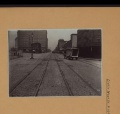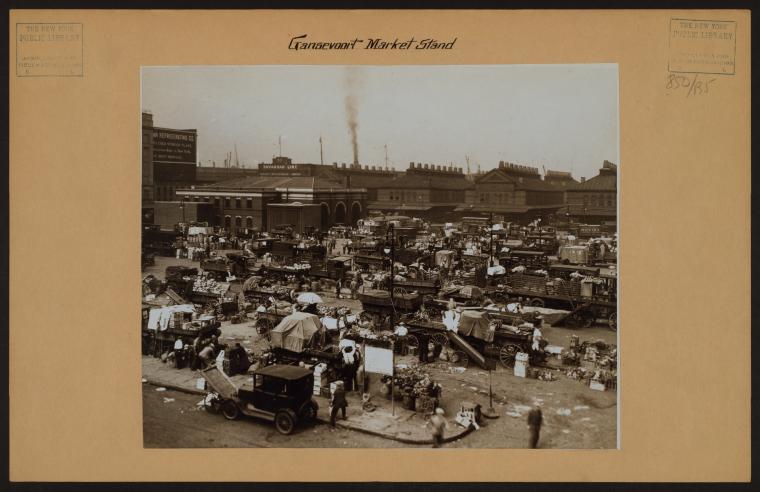User:Theresa DietrichFrom The Peopling of New York City
Welcome to Little West 12th Street: From Industrial Slaughter Strip to Chic Nightlife Stretch
IntroductionWelcome to Little West 12th Street! This small cobblestone street lies at the heart of the meatpacking district, falling between 9th Avenue and Washington Streets, on the outskirts of Greenwich Village. I initially became interested in Little West 12th Street for it's splendid facade. The street is presently riddled with high end shops, restaurants and nightclubs alongside abandoned slaughterhouses and industrial warehouses. The contrast struck me. After doing a little research I realized that this street had much more to tell of than just its current splendor. I found that Little West 12th Street kept gracefully concealed a past wrought with meatpacking, gay subculture, Greenwich Village bohemian life and so much more. I have not consolidated my exploration of this street to any singular event, it is the notion of profound change which intrigues me. The common thread which connects the disparate histories of Little West 12th Street is the notion of exclusion. Gay men took refuge here in order to escape societal judgment, slaughterhouses operated in exclusion from residential life in Greenwich Village, and the surrounding neighborhood's reputation for unconventional lifestyles attracted nonconformists of all types. My project will focus primarily on the historical aspects of this street, beginning with the birth of Greenwich Village as a country hamlet in the 1700's and following the areas industrialization via produce and meat markets, finally culminating with the transformation of the street into a nightlife and entertainment enterprise.
Getting Around: Links
Maps and Introductory ProposalLittle West 12th Street, Meat Packing District
My Research JourneyBrooklyn College LibraryI started my research at the Brooklyn College Library and considered my findings moderately successful. I was able to discover several books concerning Greenwich Village's History, but nothing specifically on Little West 12th Street. (A Freewheelin’ Time : A Memoir of Greenwich Village in the Sixties by Suze Rotolo, The mural at the Waverly Inn : a Portrait of Greenwich Village Bohemians by Edward Sorel, and Art and sex in Greenwich Village : Gay Literary Life after Stonewall by Felice Picano) I wasn't able to obtain much pertinent information from these books, I more or less scanned them and obtained a general impression of Greenwhich Village Bohemian life and gay subculture. Online databases were also helpful, I used Project Muse and JStor to find a few scholarly articles on the history of meatpacking in New York City and in the larger United States. I quickly discovered that the archives did not apply, housing records strictly for Brooklyn. NYPL: 5th at 42nd BranchI had a very pleasant research experience when I finally got around to visiting the New York Public Library. A librarian helped me obtain several good sources including The Encyclopedia of New York by. During this trip I got a better overall portrait of Greenwich Village's history as well as some insight into my subtopic: meatpacking on Little West 12th Street. Municipal ArchivesThis Chamber's Street excursion proved a bit disastrous. I went in, still with a very general concept of my project and was overwhelmed by the specificity of available information. Since I had not pin-pointed any singular business or names, the archives were largely unhelpful to me. This failure prompted me to identify the research that I needed and to identify connecting thread of my project. Finding historic meat packers, or businesses, along the street was proving unfruitful and there were virtually no residents in the industrial area, I decided to make the focus of my project the streets simultaneous profound reinvention and historical containment of atypical enterprises. At this point I identified two disparate threads of research with one uniting commonality; exclusion. Firstly, I wanted to provide a history of meatpacking focusing on it's exclusion from residential life in Greenwich Village. Secondly, I was interested in the street's place as a refuge for the gay subculture who faced exclusion in mainstream society. Jefferson Market LibraryThis outing proved both pleasant and productive. I thought it would be helpful to visit the Greenwich Village branch of the NYPL, they house a special collection of Greenwich Village history. I found a lot of overlap, seeing as I already had a lot of background on the Village's history, but a helpful recommendation from the librarian did lead me to Census statistics, available on the Greenwich Village Historical Society's Website as well as the NYPL digital collections, which provided an interesting history in images. A Walking Tour via Flipvideo
Greenwich Village: A General History
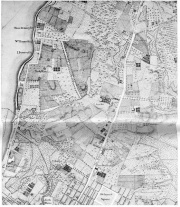 map of rural Greenwich Village circa 1760[6] Early History [16th-18th Century]From its very inception, Greenwich Village was a unique part of New York City. The area’s oldest history begins in the 16th century when the land was inhabited by the Native Americans who dubbed the land ‘Sapokanican.’ [7] The next peoples to occupy this land were the Dutch who turned the marsh into sprawling farmland via their African Slaves. (See picture of rural G.V.) By 1713, the land was considered a country hamlet (or rural settlement to small to be considered a village). [8] Meatpacking and Industrialization [19th and 20th Century]After establishing the Village’s founding within the colonies, it is pertinent to move on to the area’s 19th and 20th century hasty particularly in regards to the development of the things which interest me along the street: meatpacking, gay subculture, and G.V.’s reputation for non-conformity. 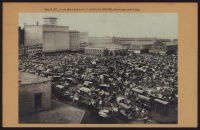 Picture of the chaos as described in Harper's Weekly 1888: "During the dark hours of early morning, as hundreds of wagons of all descriptions converge upon the market regions, pandemonium reigns as traffic chokes the thoroughfares for blocks around [9] . NYPL Caption: West Street from Gansevoort to Little West 12th Street, near North River showing market day at the Gansevoort or Farmer’s market, 1900. Greenwich Village began to become industrialized with the inception of markets in 1884. It is important to note that the history depicted is particular to a small section of Greenwich Village, the Gansevoort Market Historic District, which includes Little West 12th Street. “The rough boundaries of the district are W. 16th Street to the north, Hudson Street to the east, Gansevoort and Horatio streets to the south, and the Hudson River to the West. [10] (See diagram). The three most notable markets which survived along the street were Gansevoort Farmer’s Market (1884), West Washington Market (1887), and finally, Gansevoort Meat Center (1949). [11] The original market was an open-air produce arrangement, this was amended when the “city decided to add meat, poultry, and dairy products to market activity” spurning the creation of West Washington Market in 1887. [12] The next relevant market, Gansevoort Meat Market, was built in 1949 on the site of the former Gansevoort Produce Center. [13] “Meat eclipsed produce as the stronghold of the area.” [14] This change from markets to meat markets marks an important part of Little West 12th Street's history, the advent of meatpacking the the prime industry along the street would continue to shape it's history through the 21st century. A Photographic History of Markets [NYPL Digital Archives]
Gay Subculture and the Greenwich Village BohemianThe narrative of Little West 12th Street seems utterly incomplete without the inclusion of it's rich social history, centered around gay subculture and the life of the Greenwich Village bohemian. Exclusion drew these various non-conformists to the area, the sparsely populated and heavily industrial street proved the perfect refuge for subcultures of all types. Greenwich Village underwent striking changes during the early 19th century, making the neighborhood even more attractive to outsiders. “During the early 19th century new institutions served the spiritual, educational, and cultural needs of the growing community.[20] The advent of German, Italian, and Irish immigrant to the neighborhood also contributed to the area's diversity. By the turn of the 20th century, Greenwich Village was generally recognized as a "bohemian enclave with secluded side street, low rents, and a tolerance for radicalism and non-conformity."[21] Felice Picano depicts the gay literary movement which began in the village a decade after the Stonewall rebellions, in his novel Art and Sex in Greenwich Village. He tells the history of a small, all-gay press called Seahorse which began along with Calamus Books and JH Press. All three eventually came together to form Gay Presses of New York, expanding gay culture to bookstores, magazines, newspapers, theater companies, and art galleries, all which grew out of Greenwich Village.[22] Suze Rotolo further illustrates this nonconformist allure of the Village in her memoir A Freewheelin’ Time: A memoir of Greenwich Village in the Sixties:
“But it was to Greenwich Village that people like me went – people who knew in their souls that they didn’t belong where they came from. I was drawn to the village with its history of bohemia - where the writers I was reading, the artists I was looking at had lived or passed through.”[23]
David Carter's novel, Stonewall: The Riots that Sparked the Gay Revolution investigates not only the allure, but the necessity of Greenwich Village and Little West 12th, as a refuge for budding gay subculture. Secluded industrial streets, such as Little West 12th, proved to be ideal meeting places for gay men seeking companionship anonymously. "It was the villages reputation for unconventional lifestyles that first attracted gay people to the area around the turn of the century as they sensed that a place known for its wide tolerance might even accept sexual nonconformists." [24] Greenwich Village Demographic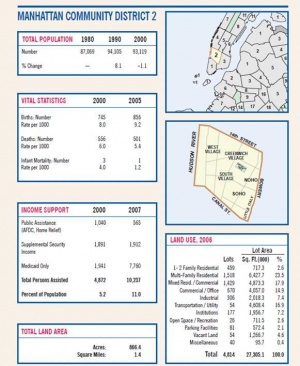 Population of Greenwich Village[25]  Land Use of Greenwich Village[27] This land use chart is largely illustrative of Little West 12 Street's simultaneous inclusion and distinction within the Greenwich Village neighborhood. This is important because although the street is undeniably included in the rich history or Greenwich Village, it also has its own, very disparate past. This is evidenced primarily by Little West 12th Streets curious dissimilarity on the land use chart which illustrates that it is devoted largely to industrial manufacturing (purple), which comprises a meager 7.4% of Greenwich Village's total land use. There is also curiously no residential colors detonated in the area surrounding Little West 12th Street, although according the 2006 Land Use chart, Greenwich Village is nearly 50% residential. Other noteworthy land uses along Little West 12th Street are Transportation and Utility (black) and Parking Facilities (grey) together comprising only about 18% of Greenwich Village’s overall land use.[28]
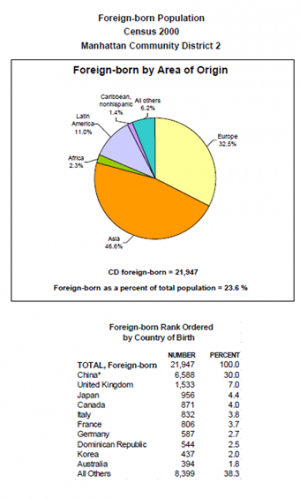 Ethnic Make-up Greenwich Village[29]  CLICK TO ENLARGE! Income and Education (first panel) Age and Nativity (second panel) and Total Population by Mutually Exclusive Race (third panel) all according to the 2000 Census. I posted this because I thought it was pertinent in forming an accurate impression of Greenwich Village's current make-up. All the data in this section was stumbled upon per a recommendation from a librarian in the Jefferson Market Library in Greenwich Village, one of my most fruitful research ventures. She suggested checking out the Greenwich Village Society for Historic Preservation's website to find census data as well as other interesting statistical information, all of which was contained in PDF's from the Department of City Planning's Website.[31]
A History of Meatpacking I used this source at the main branch (42nd St) of the NYPL. I was unable to find a listing of my street, but it was mentioned within the Meatpacking article.[32]
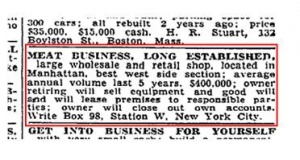 This classified add from 1857 is evidence of the economic turmoil and sanitation laws which caused many meat packers to have to sell their businesses.[35] The Rise and Fall of the Meatpacking Industry along Little West 12th Street The rise of markets, firstly produce and later meat (as described in “Markets and Industrialization”) lead to the establishment of the meatpacking industry along Little West 12th Street. There are signs of this industry’s previous prevalence along the street still today. “The ghostly remains of the old meatpacking district sulk in the shadows. Once the largest center or beef production in the county, New York was host to dozens of stockyards, slaughterhouses, and processing plants in the 19th and 20th centuries.” [36]  Sigmund Weichsel’s obituary, along with a short anecdote of his life which mentions his role in Weichsel Beef Co. and that the company will contribute to her funerary expenses[37] One such producer, Weichsel Beef Co., still stands uncomfortably out of place at the intersection of Little W. 12th and Washington Streets with only the traffic of the West side highway to keep it company. Three large trucks parked outside and painted with the company’s emblem indicate that the sad looking building is still in business. Hoping to attach this desolate street to some kind of human lineage, I did an Ancestry.com search for Weichsel’s born in New York. My most promising result was Sigmund Weichsel born in the Bronx in 1907. His brief obituary alludes to his role in the company. Without any other promising leads, I decided to focus my exploration of meatpacking along Little West 12th Street more generally, concentrating on the factors which contributed to the rise and fall of this industry and the reasons for its exclusion to industrial streets such as Little West 12th. I’ve already established the rise of meatpacking in the area, via the various Gansevoort Markets. This close by industry, coupled with the street’s desolation and exclusion from the more residential Greenwich Village, made Little West 12th Street an ideal spot to host the often unpopular meatpacking industry. There were several reasons for the disapproval of this industry, instigating its exclusion to sparsely populated areas, the first being excessive waste. “By the 1850’s thousands of animals were being slaughtered in New York City generating millions of pounds of stinking organic waste.” [38] In response to this problem, whole industries sprang up to convert waste into products such as leather, wool, cloth, lard, tallow, candles, soap, oil and glue. This response, says Christine Meisner Rosen in her article The Role of Pollution Regulation and Litigation in the Development of the U.S. Meatpacking Industry, was a testament to our desire to make use of all waste and the fear incited by “foul stenches emitted when organic materials decayed, something that people had associated with disease, death, and moral impurity since ancient times.” [39] Attempts to convert waste to usable material proved marginally successful, but unused waste still existed. It was often discharged into streams and waterways or carted off to place where it could be dumped or buried. It often got stuck in the walls and crevices in the floors of slaughterhouses. Exacerbating this problem, early meat packers did not boil the bones or fat of butchered animals, but rather stacked them on cars in the street. This was especially problematic in how weather when “the carts that carried the waste to the fat and bone boilers often dripped with stinking putrefaction as the trundled through the streets.” [40] In order to combat these problems, zoning and nuisance laws sprung up in an attempt to regulate the industry. These regulations, along with a slew of other economic problems, lead the fall of many meatpackers. “Labor strikes, competition, and sanitation laws conspired against the [meatpacking] industry in the second half of the 20th century, until most of the trade was concentrated around west 14th Street. In more recent years, even that small foothold has given way to real estate development.”[41]
The Street that Never Sleeps: Little West 12th Street's 24 Hour Economy
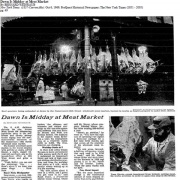 1933 New York Times Article entitled "Dawn is Midday at Meat Market"[42] Another important factor which has kept Little West 12th Street operating in exclusion is the unique time frame which the street has abided by historically, and still today. A 1933 article about NYC's meat industry proclaims, "Dawn is Midday at Meat Market."[43] David Carter confirms that nighttime activity continued along the street into the 1960's in his novel, Stonewall: The Riots that Sparked the Gay Revolution. He describes secret meetings which took place alongside the Hudson River, always under the cover of darkness. "The marginal quality of homosexual existence was rendered literal in the village along the waterfront. While the shores of oceans, lakes, and rivers are still used in many cities by gay men as places to meet because of the privacy the afford, in the postwar village, the banks of the Hudson River became a meeting place because of the trucking industry." [44]. 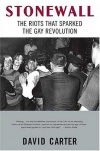 Stonewall by David Carter[45] The street's sleeplessness continues today, perhaps more notably than ever before. Producers, in the form of meat packers and butchers, have been replaced by a new breed of night shift laborers on Little West 12th Street, and consumers are demanding something entirely different from them. Nighttime along the cobblestone street has always catered to a certain necessity, once in the form of food for the city's consumption, now a different sort of need is met. I'd like to take this opportunity, this common thread between past and present, to transition fully to the current moment and examine the forces at work along Little West 12th Street today.
Little West 12th Street TodayCurrently, Little West 12th Street functions largely as an entertainment enterprise. Many of the street's old warehouses have been converted to upscale restaurants and clubs. By the light of day, the Street still looks like an abandoned version of the old Gansevoort Meat Market. A rusty sign proclaims, "Weichsel Beef Co" and abandoned warehouses stand empty. Its outdated daylight disguise can deceive. 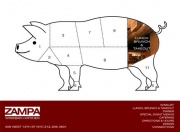 Restaurants such as Little West 12th Street’s, Zampa, exploit the streets sorted history to their advantage, playing on the irony of the leisurely nature of a once strictly industrial street.[46] By midnight, the small street transforms itself, illuminated by the soft glow of candlelit dinner tables and the small flashlights bouncers use to check IDs. To the left, impeccably dressed yuppies line up outside the humble French restaurant, "Pastis." Across the street, revelers step outside the "Buddha Bar," a pan-Asian sushi lounge, for a cigarette. "The cobblestones of Little West 12th Street can be tough on the stiletto hells worn by many of the meatpacking district's stylish patrons, but these restaurants make the balancing act worthwhile," boasts an article in the New Yorker about the up and coming street's trendy appeal.[47] The newest addition to the street's long history, is chic statehouse, "STK" and it's nightclub counterpart "Tenjune."[48] This street's profound reinvention, however, has not come without consequences. "The meatpacking district has replaced Chelsea as the epicenter of the Manhattan party scene - and home to all the woes that follow. The venerable neighborhood hosts and assortment of less savory sorts each weekend: Drunks. Cokeheads. Dealers."[49]
ConclusionBeginning this project, I was initially intrigued by the irony of a street with a past and present so blithely disconnected, yet somehow contingent upon one another. About midway through my research, the common thread of exclusion occurred to me as I was looking into Little West 12th Street’s sordid history. New York, a city which is touted as one of the most tolerant, ethnically and socially diverse, and opportunity rich places on earth, also has a quieter, less celebrated history. A history which took place on secluded side streets, in abandoned warehouses, and in the empty beds of commercial trucks. Little West 12th Street has witnessed this non-traditional history and provided refuge to those who were denied acceptance in a city which prides itself on the very notion. Little West 12th Street has opened its arms to the necessary unpleasantries of the meatpacking industry, the stigmatized gay and transsexual communities, and political and social radical of all types. The street’s historic exclusion from the city’s mainstream only enhances the irony of its present condition. Little West 12th Street now hosts many forces that once worked against its inhabitants – wealth, power, privilege. By examining this street’s journey from an industrial slaughter strip to a supremely trendy nightlife breeding ground, I learned an invaluable lesson about the unending faculty for resilience present only in New York City. As former mayor Phillip Hone once said, “Overturn, overturn, overturn! Is the maxim of New York.”[50] The obsolete has the possibility of becoming cutting edge, and the excluded, the opportunity to find acceptance. New York, along with Little West 12th Street “exemplif[ies] the spirit of pulling down and building up.”[51]
References
|

